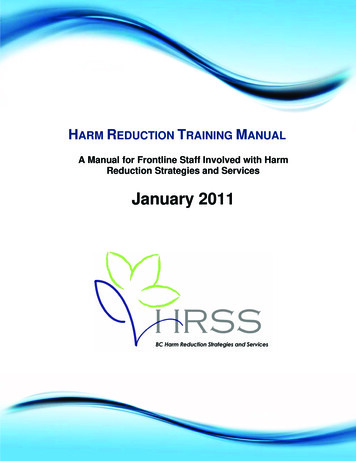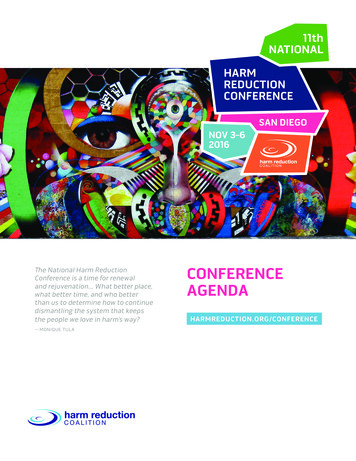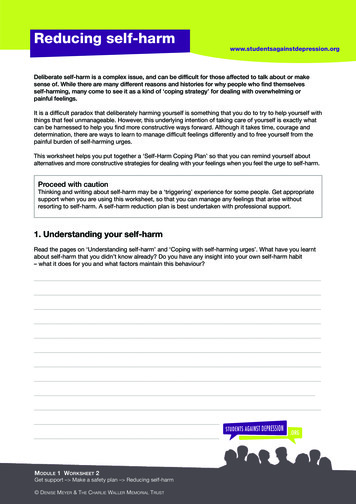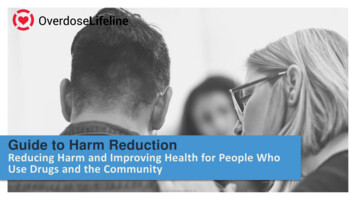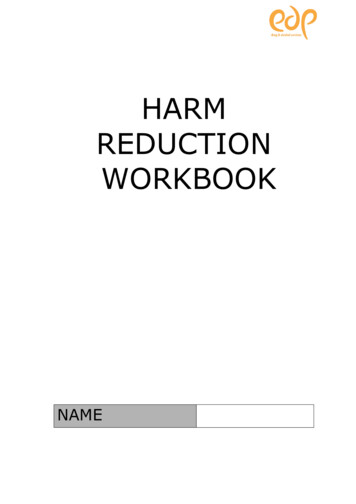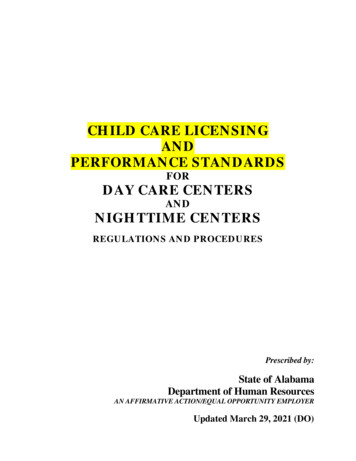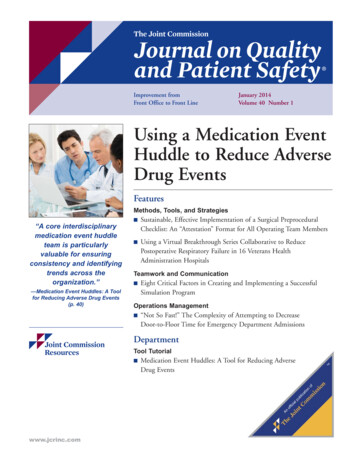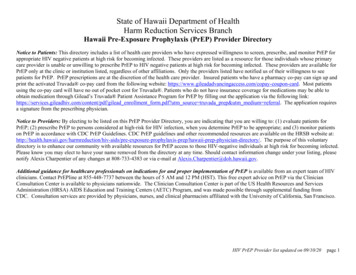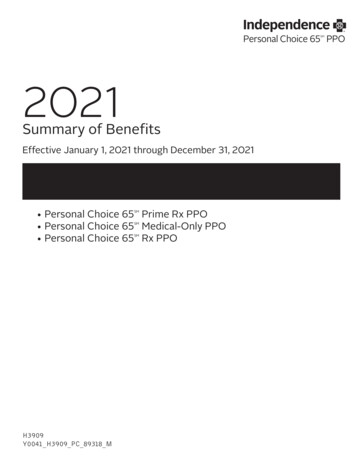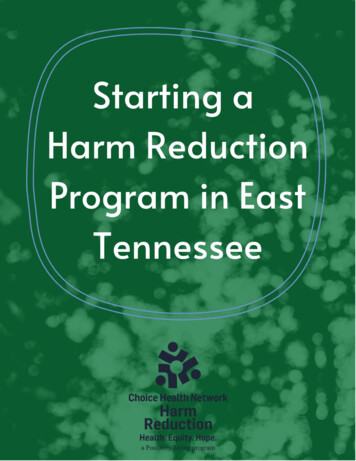
Transcription
July 2020Choice Health Network Harm Reduction1925 Ailor AvenueKnoxville, TN 37921www.choicehealthnetwork.orgEditor and Corresponding Author:Lesly-Marie Buer PhD, MPHResearch DirectorChoice Health Network Harm Reductionlbuer@choicehealthnetwork.orgContributing Authors from Choice Health Network Harm Reduction:Sam Armbruster, MPHAshley GustafsonRCORP Program ManagerVolunteer CoordinatorCAC AmeriCorps VISTA MemberLindy Clapp, MDHarm Reduction CoordinatorRachel A. IncorvatiSocial Media CoordinatorCAC AmeriCorps VISTA MemberGenoa Clark, MPPASenior Harm Reduction DirectorGreg Stafford, RN, BSNHarm Reduction Medical CoordinatorJeremy GarnerHarm Reduction CoordinatorAcknowledgementsThis guide was supported by the Health Resources and Services Administration RuralCommunities Opioid Response Program – Planning grant G25RH32990.The following groups contributed to building the services available through ChoiceHealth Network Harm Reduction and the knowledge produced in this document: ChoiceHealth Network Harm Reduction participants, Tennessee Central Appalachian OpioidResponse consortium members, Tennessee Department of Health, TennesseeDepartment of Mental Health and Substance Abuse Services, First Aid CollectiveKnoxville, AIDS United, Comer Family Foundation, DirectRelief, Gilead, HepConnect,and The Hepatitis C Mentor and Support Group.
IntroductionLesly-Marie Buer – Research DirectorChoice Health Network (CHN) provides case management, mental health and medicalservices, HIV and hepatitis C (HCV) prevention services, and Harm Reduction primarilyin East Tennessee. CHN Harm Reduction began offering services in 2018, providingsyringe services (SSP), naloxone training and distribution, HIV and HCV testing, linkageto care, and wound care. CHN Harm Reduction has been operating in Knoxville since2018, and will expand to Cocke County, Tennessee in 2020.In 2019, CHN Harm Reduction received a Health Resources and Services AdministrationRural Communities Opioid Response Program (RCORP) – Planning grant for Campbell,Cocke, Jefferson, and Scott Counties, Tennessee. Through this grant, we facilitatedTennessee’s Central Appalachian Opioid Response (T-CAOR) consortium to createvarious assessments and plans to reduce rates HIV, HCV, overdose, and substance-userelated infections through the provision of Harm Reduction services. Our goals have beento begin SSPs in rural counties, to increase naloxone distribution, and to begin safetychecks for people who use drugs (PWUD) to prevent overdose deaths.Harm Reduction is a social justice philosophy created by and for PWUD. Harm Reductionaccepts that drug use is a part of our world and works to mitigate harms that come fromdrug use as well as the criminalization of drug use. According to Monique Tula, theuncapitalized “harm reduction” denotes a program that is only about reducing risks. Thecapitalized Harm Reduction, on the other hand, is an intersectional social movement thatunderstands and addresses the multiple factors that place people at risk, fromhomelessness and lack of access to jobs that pay a living wage to discrimination basedon identifying as LGBTQ .1 Harm Reduction calls for programs that empower PWUD totake care of their health and each other without stigma.There are many wonderful guides available for starting a Harm Reduction program – wehave benefitted from these and have included an informational resource list in thisdocument. Our goal is not to recreate what has already been done, but to add to existingresources from our own experiences. Many guides are focused on areas that may notlook like East Tennessee – they may not have our rurality, our legislation, and certainlynot our beautiful hills. This is what we have found that works for us in this context. Asalways, please reach out to us if you have questions, suggestions, or just want to seewhat we are up to.WEBSITE: choicehealthnetwork.orgINSTAGRAM/FACEBOOK: @chnharmreductionPHONE: 865.208.7356TWITTER: @HR choicehealthGodfrey, Will. 2018. “The Harm Reduction Movement: Bigger than Ever, but Facing Threats.” vement-bigger-than-ever-but-facing-threats/.11 Page
Policies and FundingGenoa Clark – Harm Reduction DirectorTennessee State LawsFederal, state, and local policies largely dictate the operation of syringe service programs(SSPs) in Tennessee. Below are relevant state laws for SSP operators and participantsthat involve syringes, injection supplies, naloxone, and responding to an overdose.Needle Possession/Officer Awareness (TCA 40-7-124): If you are stopped by an officer, let them know immediately that you havehypodermic needles. If you alert law enforcement to the presence of needlesbefore they search you or your vehicle, you should not be charged or prosecutedfor possession of drug paraphernalia for the needle(s).Safe Syringe Act (TCA 68-1-136): The 2017 Safe Syringe Act is a limited immunity law. You are protected from beingcharged or prosecuted for needles as drug paraphernalia IF a) you are aparticipant and have your ID card; and, b) you are traveling to or from the SSPduring the days and hours of operation. The law can be found here: /TN.SANE.Final.SB806.HB770.18May17.pdfGood Samaritan Law (TCA 63-6-218): Provides immunity for administering naloxone to those acting in good faith thatsomeone is experiencing an overdose.Overdose Prosecution Immunity (TCA 63-1-156): Provides immunity from being arrested, charged, or prosecuted for drug-relatedviolations if you experience an overdose or call 911 about someone experiencingan overdose. This ONLY applies to the person’s first overdose involving 911 oremergency services.Tennessee state guidelines for starting a SSP: Tennessee law requires SSPs to be state-approved in order to operate legally. Theapplication process for operating a SSP contains key components of the SafeSyringe Act, including approval of each site by the state (sites must be 1000 feetfrom parks, schools, and greenways in metro areas and 2000 feet from parks,schools, and greenways in rural areas). The application to apply can be found here: reas/SSP%20Registration%20Form TDH.pdf Tennessee SSPs are prohibited from using ANY public funds to purchase needles(federal, state, or local). Any program considering operating an SSP should beprepared to find private funding to provide supplies.2 Page
FundingControversy, lack of support, and legalrestrictions can make operating SSPs costprohibitive. Creating a braided funding streambased on grants, financial donations, in-kinddonations, and organizational support (ifpossible) allow for a diverse and sustainableprogram budget. Grant proposals are anintegral part of the planning process forbeginning an SSP.In terms of in-kind donation, the TennesseeDepartment of Mental Health and SubstanceAbuse Services donates the Narcan wedistribute through CHN Harm Reduction(shown on the right). DirectRelief donates theintramuscular naloxone we distribute. Beloware some tips for sourcing funding and supplies.Pay yourself for the work you already do: Make sure staff and Harm Reductionsupport (see Volunteer and Support Staff Engagement section) are paid for theircontributions so that everyone who is engaged in providing services can reliably get apaycheck and go home and take care of their families. They are the backbone of thework!What are you already doing and how can you tailor your grant proposal to make sureyou’re not always adding more to your workload? Pay special attention to generaloperations funding, funding to pay for overhead, and funding that applies to theprogramming you already have instead of proposing brand-new programming for eachgrant.Not all money is good money: Often Harm Reduction programs are used to comingfrom a place of scarcity, but there are some funding sources that have other costs toconsider. Here are some things to think about: Does the funder fit with your program’s and organization’s values? Are the grant’s reporting requirements and goals realistic? Will the application process be an undue burden? Is staff time dedicated to grant-writing going to mean the program will be shortstaffed while focusing on the proposal?Rejection isn’t personal: Make a better proposal and try again! Being rejected doesn’tmean the grantor is necessarily a bad fit – regroup, re-apply, and ask for feedback fromfunders when possible.3 Page
Program FlowSam Armbruster – RCORP Program ManagerA Typical Day at SSPPrior to the COVID-19 pandemic, CHN Harm Reduction in Knoxville operated out of astate-approved, fixed-location site, in the cafeteria of a local social service organizationthat primarily provides services to unhoused individuals. We used a van to bring suppliesto the location, including: new participant enrollment forms, participant identificationcards, syringes, safer injection supplies (cookers, tourniquets, cotton filters, band-aids,alcohol pads, sterile waters, sharps containers), syringe disposal bins, fentanyl test strips,nasal Narcan, intramuscular naloxone kits, wound care supplies, HIV and hepatitis C(HCV) test supplies and forms, HCV prevention kits, condoms and lube, a water coolerand cups, and cleaning supplies. It takes about 20 minutes for the team (and participantswho always insist on helping) to set-up.Each member of theteam has their owntable where theydeliver services, withtheir own inventoryofsupplies(asshown to the left).There is also a tablewith supplies for ourphlebotomistwhodraws blood forconfirmatoryHCVtests, in addition tomeetingwithparticipants who arenot being tested.Near the blood drawtable is a centrallylocated station where tests can be placed while they process. Test results are given in aseparate room from the exchange to provide a private space for results. In the case of apositive test result, staff work together to connect an individual to the appropriate care.At this location, participants usually had to wait in line for services. Next to the line, weplaced a table with a basket of condoms, lube, a water cooler, and cups where individualscan easily access and take whatever they need. Staff or volunteers who are working theline talk to participants while they wait. If participants are new, they are asked to fill outenrollment paperwork and are given an anonymous, unique identification card; ifparticipants have lost their identification card, they are provided a new card. These samestaff or volunteers distribute nasal Narcan and intramuscular naloxone and providetraining of their use while people are in line.4 Page
Participants choose to go to whichever table they would like – many participants will waitto see a specific person with whom they have built trust.Participants take a seat at a table and drop their used syringes into a sharps disposal bin.Staff or volunteers greet the participant and share their own name, while emphasizingthat because it is an anonymous service, the participant does not need to share theirname in return. All participants are asked the following:* What is your identification code?* Have you been tested for HIV and HCV in the last 30 days?* If you have not been tested, would you like to be tested today?* Have you reversed any overdoses since your last visit?* If you’ve reversed an overdose: Did the person survive? How many doses ofnaloxone did you use? What drug or drugs were the person using?* Have you used any fentanyl test strips since your last visit?* If you have used a fentanyl test strip: What were the results of the test strips andwhat drugs did you test?* How many syringes are you bringing back?Although there is a script of questions, the format is more conversational. Staff ensurethat there is a chance to discuss other topics participants are interested in, ranging fromthe good things happening in their lives to needs they would like to receive support for. Ifthe participant wants to get tested for HIV or HCV, staff perform the test(s) and bring thetest(s) to the table, where it stays until it has processed and it is time to give the participanttheir results. If they have received a positive HCV antibody test before, they can chooseto get a confirmatory blood draw that day. Participants can wait at the exchange to receivetheir results that day, leave and return before the exchange ends, or get their test resultslater. After the exchange ends, staff and volunteers sweep up any trash, wipe surfacesdown with a bleach solution, and re-load the van.The New “Normal” of the PandemicAt the beginning of the pandemic, CHN Harm Reduction halted services for two weeks todetermine the safest way to provide services while maximizing safety. No volunteers areworking at SSP during this time to limit potential exposure. The most important aspectsof providing services during this time have been flexibility and a willingness to shift howservices are provided.Currently, much of the Harm Reduction program looks the same as it did while operatingout of the indoor fixed-site location: packing the van, the questions asked of participants,and the supplies that are provided. There are two major differences. We currently operateoutdoors in a parking lot to prevent close contact and to provide an open-air space. Theother difference is that participants are asked to call a phone monitored by a teammember to make an appointment for a multiple-hour time slot during a specific day. Thisgives participants flexibility, but also helps ensure that no crowds form. People call or textthe scheduling phone and are offered a specific day that they can come to pick upwhatever supplies they need.5 Page
When participants arrive, they are required to wear a mask and practice social distancing(maintaining six feet of distance from other people). If they do not have a mask, weprovide one.Participants approach aclearly marked tablewhere a staff memberasks the questionslisted above and findsout what supplies areneeded. Another staffmemberwhoisstationed in the back ofthe van packs a bagwith the requesteditems (as shown to theright). The supplies thatparticipants can requestare the same, thoughwound care supplies,condoms and lube, andsafer injection suppliesnow come in prepackaged kits. Afterpacking items for theparticipant, one of thestaff members place thebag on the ground sixfeet or more away from the participant and step back so that they can pick up their items.If the participant needs to be trained to use naloxone, staff provide that training.Individuals can pick up supplies for others who may be unable to make it to the exchange.What the Future HoldsAt the end of the pandemic, CHN Harm Reduction will likely be providing services fromtheir office location and will have established a Harm Reduction program in CockeCounty as well. It is difficult to imagine what form the exchange will take, but it willundoubtedly take many forms before it becomes concrete. One of the most importantthings to remember is that in Harm Reduction, meeting people where they are meansbeing flexible and willing to make changes to best meet the needs of participants!6 Page
Outreach and EducationJeremy Garner – Harm Reduction CoordinatorOutreachCHN Harm Reduction does outreach in a variety of settings with different populations.With academic institutions, community-based organizations (CBOs), and advocacygroups, we often focus on explaining the importance of Harm Reduction, destigmatizationof people who use drugs (PWUD), and why it is crucial to include PWUD in any programplanning or decision-making processes. To reach even broader segments of thepopulation, we table at health fairs and conferences relating to health and substance use.We offer education, naloxone distribution, and/or HIV and hepatitis C (HCV) testing atthese tabling events, depending on the circumstances.We also make efforts to reach PWUDthrough more targeted actions. Weregularly complete outreach in ourdowntown area, in bars, in a few localmedication-assisted treatment (MAT)facilities, and within partnering CBOs.This outreach includes naloxone andadditional supply distribution, educationabout Harm Reduction, and HIV andHCV testing. Of note – due to Tennesseelaws regulating where syringe servicescan occur, we generally cannot offersyringes at these locations. All of theseevents and actions often represent thefirst time we introduce someone to ourprogram – which can be an opportunetime to tell potential new participants ortheir friends and family members about our programming, to educate potential communitysupporters about what we do, and to recruit volunteers, as discussed more in a latersection.Outreach also occurs with Harm Reduction participants. If someone tests positive for HIVor HCV, for example, we communicate their status and link them to available services.This outreach involves contacting people through everyday avenues (e.g. text, email),and finding other ways to contact people if that doesn’t work. We have built strongrelationships with social service providers who work extensively with people who areunsheltered so we have better chances of finding participants who do not have phones.Our team is familiar with many of the camps where people who are unsheltered live, andregularly check those areas as well. Most of our participants mistrust law enforcementand other state institutions that are punitive. Understand and be honest about yourrelationships with these institutions and what exactly that means for how yourorganization is perceived and how your participants are treated.7 Page
This type of outreach can involve development of intense ties and some participants coulduse extensive support to navigate the high-risk environments in which they’ve beenplaced. Staff boundaries and self-care become critical here. Some of those boundariesmight be with work itself (e.g. turning off the work phone on weekends) or with individualparticipants (e.g. not publicizing staff’s personal cell numbers). Discussing boundariesand respecting, rather than criticizing, those boundaries has been important to us as ateam as we see it as a fundamental aspect of self-care. Being clear with other staff andparticipants about our boundaries leads to a type of communication and trust that is basedon honesty and sincerity, rather than a person straining themselves until they aredysfunctional. This may be a time to speak with participants about boundaries in theirown lives. It also provides space to at times prevent and other times navigate the vicarioustrauma both staff members and participants regularly experience.Setting boundaries is not only about staff protecting our inner worlds, but also not lettingingrained values based on stigma seep into our outreach. We have found that a vital partof outreach is not imposing our personal will, especially as it relates to substance usetreatment. Since we are all taught certain values throughout our lives, this can be a hardthing to do. For us, the first step has been examining our values, discussing how certainprivileges we have influence values, and trying to understand how our values shape ourwork. Harm Reduction asks us to shift values from “saving” someone, to meeting peoplewhere they are at, asking and, if possible, providing what support people ask for, andrespecting people’s autonomy and decision making. Overall, this means being open,listening, and asking questions of participants, not to be nosy, but to show care and togain a better understanding of their circumstances. Consistently showing the respect,empathy, and dignity that Harm Reduction requires leads to trust and alliance.Participant EducationMuch of the participant education we do is when someone tests positive for HIV or HCV.But we are asked many questions, especially about locally available resources. We keepreferral information for local food pantries, housing support, mental health providers, HCVand HIV treatment, and substance use treatment.If someone tests positive for HIV, in the moment, we answer any questions they have andquickly connect them with the CHN clinic, so they can be connected to clinical and socialservices as soon as possible. Additional education comes with the first medical and casemanagement appointments.There are not as many resources for those who test positive for HCV. Participants,especially those who are uninsured, may not have immediate access to HCV treatment,and therefore do not have access to individualized conversations with a treatmentprovider. Thus, most education participants may receive will be coming from our team.We provide basic information on the different types of hepatitis, routes of transmission,and treatment providers that are available locally. The Centers for Disease Control andPrevention and The Hepatitis C Mentor and Support Group (see the Further InformationalResources section for their websites) have useful handouts for participant education.8 Page
Clinical Services and Clinical EducationGreg Stafford – Harm Reduction Medical CoordinatorTestingWe have integrated opt-in HIV and hepatitis C (HCV) testing into our syringe servicesprogram (SSP). When someone sits at our table for SSP, we ask if they have been testedfor HIV and HCV in the last three months. If they say no, we tell them that we recommendtesting every three months, provide some education, and ask if they would like to betested. If they say no, we say okay, and move on. Part of Harm Reduction is respectingpeople’s autonomy over their health, and not coercing people into using certain servicesis part of that respect. If someone would like to be tested, we explain the process, reviewconsent, and complete necessary paperwork, which we have streamlined as much aspossible to reduce barriers to testing.Hepatitis is the most common chronic blood pathogen, causing inflammation and damageto the liver over time. Three types of hepatitis are most widespread in the United States:Virus TypeHow TransmittedTreatment AvailabilityVaccine AvailabilityHepatitis A(HAV)Fecal-oralSupportive treatment onlyYesHepatitis B(HBV)Blood/bodily fluidsSupportive treatmentonlyYesHepatitis C(HCV)Blood/bodily fluidsSupportive treatment/antivirals that can lead to cureNoHCV is ten times more contagious than HIV and the scarring that it produces to the livereventually leads to cirrhosis. Bleaching syringes and supplies is not an effective meansto kill HCV.HCV testing is a two-step process. The first test is a rapid screening using a finger stickthat detects HCV antibodies in the blood. If someone has ever been exposed to HCV,they will always test positive for HCV antibodies. Thus, if someone has ever had a reactiveHCV antibody test, they do not need to be screened a second time for antibodies – thetest will always show that they have antibodies. Having HCV antibodies does not meanthat a person has an active HCV infection. The Tennessee Department of Health providesHCV antibody rapid tests to various organizations and requires a training thataccompanies testing.If someone has a reactive HCV antibody test, they are referred to confirmatory testingthat determines if they have an active infection. Confirmatory testing is integrated within9 Page
our SSP and requires a blood draw. There are several complications that can occur withHCV testing: After exposure to HCV, there is a window period where antibodies may not appear; And, co-infections with HIV may give false negative results due to the body’sinability to form antibodies to HCV.If we confirm that someone has an active HCV infection, we make every attempt to linkthem to care. Since HCV treatment remains difficult to get due to financial and insurancerestrictions, at times that linkage becomes individualized HCV education.HIV is a virus that is transmitted through blood, semen, pre-seminal fluid, vaginal fluid,rectal fluid, and breast milk. There is currently no HIV cure, but treatment can lead to viruslevels being undetectable in the body. A common phrase is now “U U,” which means thatif someone’s viral load is undetectable, then the virus is untransmittable. There are alsopharmaceuticals that can help prevent HIV infection. Post-exposure prophylaxis (PEP)can prevent the transmission of HIV to someone who is HIV-negative if taken within 72hours of exposure to HIV. Pre-exposure prophylaxis (PrEP) may be used by someonewho is HIV-negative to prevent the transmission of HIV to themselves.HIV testing is done with two different rapid antibody tests that screen blood acquiredthrough finger sticks. Two reactive screens confirm HIV. If someone is confirmed to haveHIV, we immediately refer them to clinical care through Choice Health Network, wherewe have a rapid start system to ensure participants can access medications as soon aspossible. If an organization is undertaking HIV screening, it is vital that participants aretold their status and connected to clinical care as soon as possible. The treatment for HIVis antivirals that help lower the amount of virus in the blood, hopefully leading to anundetectable status. There are also wraparound services available to people living withHIV.Additional Clinical ServicesPrior to delivering SSP or any clinical services, including testing and wound care,providers should be trained on bloodborne pathogens. Bloodborne pathogens aretransmitted through any bodily fluid, except sweat. A pathogen may include a bacterium,virus, or other microorganism that can cause disease. Some bloodborne pathogensmay be transmitted through direct contact, including: Direct physical contact (e.g. skin to skin, kissing, intercourse); And, droplet spread (e.g. sneezing, talking, coughing).Pathogens may also be transmitted through indirect contact, including: Airborne; Vehicle borne (e.g. syringes, injection supplies); And, vector borne (e.g. mosquitoes, fleas).10 P a g e
When talking about bloodbornepathogens, we often talk about a chainof infection, seen to the right. Breakingany one of the links between stepsstops the pathogen’s transmission.For example, using a new, unusedsyringe and injection supplies breaksthe chain at the portal of entry.On page 26, there is an “InfectionPrevention” guide that we share withparticipants. Overall, wounds shouldbe cleaned with soap and waterfrequently. Open wounds should bebandaged with a thin layer of ointment.Clinical EducationNursing student education in our program has been helpful to participants and staff, aswell as providing valuable learning experiences to our future caregivers. The mostimportant aspect for student growth is the interactions they have with participants, whereparticipants’ stories show people who use drugs as individuals navigating complexsystems. This breaks the stereotypes that students may have been taught in the medicalsystem. In our program, students have Worked in the intake line, gathering basic data from participants, enrolling newparticipants, and speaking with folks about their experiences; Assisted in delivering harm reduction services, where they learn about theprovision of services, how participants utilize different supplies, and participants’lives; And, observed clinicians administering HIV and HCV screenings as well woundcare in the Harm Reduction program setting.Overall, these experiences build empathy and encourage social interaction withparticipants in a non-medical way, thus strengthening students’ ability to have holisticconversations with future patients. Having nursing students onsite gives participants theopportunity to be knowledge producers who are involved with the training of futurecaregivers with whom they may come in contact. This is especially important for peoplewho use drugs, many of whom have had dehumanizing experiences with clinicians,clinics, or hospitals.How do you recruit students? Most colleges of nursing have clinical rotations that theyclassify as “community” or “public health” nursing. We have had success in reaching outto the professors in those classes with basic information about SSPs, their public healthimpact, and what students may learn within the SSP. If the college does not need clinicalsites, you can offer to be a volunteer site for students who want to volunteer in publichealth. This will allow you to recruit students to the SSP, but not directly link the programwith the college.11 P a g e
New Diagnoses and Linkage to CareLindy Clapp – Harm Reduction CoordinatorDelivering Test ResultsMost importantly, anyone delivering HIV and hepatitis C (HCV) results should either be amedical professional or have completed Tennessee Department of Health’s “I Know”training for HIV and community-based rapid testing training for HCV. Below are someadditional key points when delivering results.Keys to Effectively Delivering ALL Test ResultsDeliver the information clearly in a direct, neutral toneDeliver results in a quiet place that allows the person to absorb informationDeliver ALL results in the same location, so people do not feel stigmatized for beingcalled into a specific room or areaDon’t overload the person with informationListen if they want to talk, and allow moments of silence if they are visibly shakenBe flexible and supportive of the person’s needsReconfirm that their medical information is confidential, but will be reported toTennessee Department of HealthKeys to Effectively Delivering HIV Positive Test ResultsReassure them that HIV treatment has improved drasticallyLet them know that they will never have to pay for HIV medicationsReassure them that if they take HIV medications (one pill, once a day, with few sideeffects), they can live a full lifeGive them information about assistance with food, transport to appointments, dentalinsurance, housing assistance, and case management. Many people experienceimproved health and lifestyle after they are diagnosed with HIV because of theadditional assistance that comes with medical care.Linkage to CarePrior to starting tes
Greg Stafford, RN, BSN Harm Reduction Medical Coordinator . Jeremy Garner Harm Reduction Coordinator . Acknowledgements . This guide was supported by the Health Resources and Services Administration Rural Communities Opioid Response Program - Planning grant G25RH32990. The following groups contributed to building the services available .
